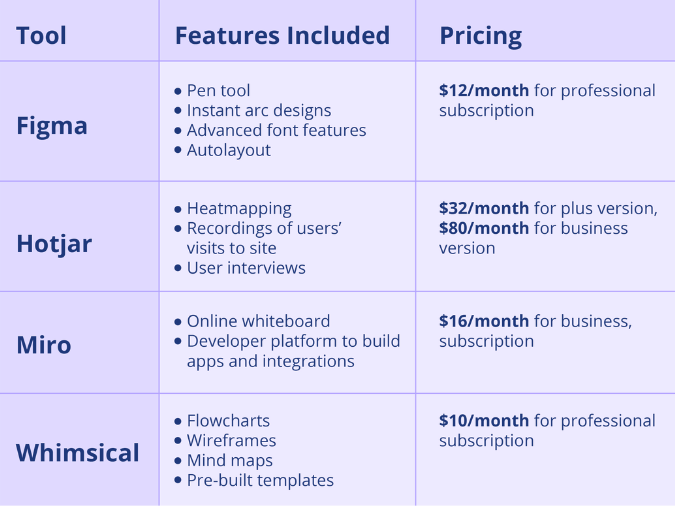How to Become a UX Writer

Most people with a smartphone toggle back and forth between applications all day — using social media, listening to music, managing finances, playing games, looking up directions, and so much more. On desktops and tablets, we use web-based apps to watch movies, file taxes, have video conferences for work, and the list goes on.
Make a Free Invoice NowUser experience (UX) is all about how users interact with a digital platform. While UX designers make sure that the app’s usability, function, and accessibility are optimal from a visual perspective, UX writers do so with the expert use of words to make the user experience as intuitive and fluid as can be.
Seamlessly integrated with design, UX writing provides the text that the user sees when navigating the app, from account signup to menu buttons to error messages. Just as an outdated interface can detract a lot of appeal from a digital product, the on-screen text that accompanies the user has a significant impact on their experience.
What is a UX Writer?
A UX writer plans and produces all the copy that intuitively guides the user through the interface of a digital product, such as a mobile app or software.
Working in tandem with UX and UI designers, developers, and content strategists, UX writers expertly craft pieces of text that are seamlessly weaved throughout the interface — also known as “microcopy” — to help guide the user through everything from onboarding to menu buttons to error screens.
In other words, a UX writer helps establish and enhance a company’s voice, similar to the way UX and UI designers help establish and enhance the digital presence or visual aesthetic of a brand. Forging a sense of familiarity and ease with the user by injecting personality into an otherwise straightforward interface, effective UX writing shapes the user experience in a positive way.
Job Outlook: Future of UX Writing
With more than 6.5 billion smartphone users and 1.1 billion tablet users worldwide, more apps and softwares are being developed than ever before. By 2023, mobile apps are expected to generate over $935 billion in revenue.
While there is not much official data available on the projected job growth for UX writers specifically, the U.S. Bureau of Labor and Statistics estimates that the job market for software developers is forecasted to grow a whopping 25% between 2021 and 2031. For web developers and digital designers, the projected growth is estimated at 23%.
This data indicates that the demand for UX writing will not stop growing anytime soon either. It is without a doubt that digital products, mobile apps, and web experiences will continue to advance and play an increasingly integral role in our day-to-day lives. And as our dependence on these technologies grows — as we spend more and more time, attention, and money inside of mobile and web apps — it is very likely that companies of all types and sizes will continue to invest in the expertise of user experience writing.
Freelance and Salary Rates
The pay rate for a UX writer varies widely based on experience, industry, location, and company size.
Freelance
For freelancers, the average rate per hour is estimated at $55, with annual income ranging from $35,000 to $157,000.
Salary
For an entry-level UX writer, the salary average is $82,804. For all levels of UX writers — from entry-level to senior — the average annual salary for a UX writer in the U.S. is $120,645.
UX Writer Roles and Responsibilities
A UX writer is an essential part of a product design team. Working closely with UX/UI designers, developers, engineers, researchers, and product managers, UX writers are responsible for championing the user experience while balancing the interests and overall vision of the business and its stakeholders.
Roles and responsibilities for a UX writer commonly include:
- Plan, write, and edit clear, concise original copy and microcopy across multiple channels (e.g. app interface, website, etc.)
- Translate complex processes and concepts into digestible and compelling in-app copy
- Develop a narrative strategy and content style guide in line with the brand’s voice and tone
- Implement and stay up-to-date with best practices for user-centered design, content strategy, and UX writing
- Conduct user testing and research to continually improve user flow and experience
- Collaborate with designers, product managers, researchers, and other stakeholders
Qualifications
Since UX writing is still relatively a new occupation, mandatory qualifications vary across the job board — from required education to the amount of prior experience.
Skills
- Exceptional writing and editing skills with firm grip on grammar; able to produce compelling and concise copy aligned with content strategy, company voice, and designated tone
- Able to work well as part of a collaborative multi-disciplinary team
- Strong attention to detail
- Able to analyze user data and relevant research to improve user experience
- Familiarity with basic UX/IX principles and terminology
- Familiarity with prototyping tools, such as Figma or Sketch
Education
While not always required, a UX writer is commonly expected to have a bachelor’s degree in English, communications, journalism, or a related field, or equivalent experience.
Training
Professional training or certification is not commonly sought out by employers. What speaks louder is work experience and tangible results delivered as a UX writer.
With that said, online courses and certification programs can be helpful in establishing confidence and know-how, with access to curated resources and assistance from mentors who are already established in the field.
Here are a few options to get you started, depending on your budget:
1. A Taste of UX Writing (UX Writing Hub)
- Introductory online course for UX writing, content design, UX writing research, user psychology, and user testing
- Cost: Free
2. Microcopy & UX Writing: The Complete Course (Udemy)
- Online course covering how to write microcopy for common UI components, develop an impactful brand voice, and boost user engagement
- Cost: $199.99
3. Fundamentals of UX Writing (UX Content Collective)
- Self-paced online certification course developed by experts from big tech companies, covering voice and tone to creating basic content deliverables and writing for UI
- Cost: $1,600
4. UX Writing Academy (UX Writing Hub)
- Six-month program diving into UX writing principles, UX writing research, product design, and real-life industry application under mentorship
- Cost: $2,995 or four monthly payments of $795
Steps to Becoming a UX Writer

Step 1: Observe and Study the User Experience
Microcopy is all around us. Whether you’re searching for new music on Spotify, ordering food delivery via Postmates, or filing your taxes on TurboTax, your experience is being gently guided by the invisible hand that is UX design and writing. All the buttons, section names, descriptions, pop-up messages, and other written elements weaved throughout the user flow of any digital interface are meticulously crafted by UX writers. Take note of what works and what doesn’t — and why.
Also, it would be a good idea to become familiar with best practices for user-centered design and keep up-to-date with the ever-evolving landscape of digital experiences.
Step 2: Learn the Fundamentals of UX Writing
Even if you are an experienced writer with a background in journalism, literature, or marketing, UX writing should not be underestimated. Not only does it require excellent writing and editing skills, but the job also demands a deep understanding and curiosity about behavioral psychology, user data, and technology. In addition, it is important to have a working knowledge of UX/IX design fundamentals and terminology in order to communicate effectively with future clients or collaborators.
Enrolling in an online course or certification program can provide guidance on learning all about UX writing, but free online resources are also available.
Step 3: Build a UX Writing Portfolio
Having a UX writing portfolio is extremely important because it demonstrates your skills, approach, and user knowledge in action. If you don’t have prior work experience in UX writing, there are other things you can include in your portfolio when applying for your first UX writing job.
Spec Work
One effective thing to include in your portfolio without prior experience is speculative work, also known as “spec work.” Similar to a case study, this allows you to observe usability issues related to UX writing in an existing app or software and provide hypothetical solutions of your own. This is an effective way to showcase not only your technical writing skills but also your creative process, rationale, and intuitive understanding of the user. Including mockups or screenshots of the “before” and “after” is recommended because, after all, UX writing is largely a visual language rooted in design.
Other Writing Samples
Writing samples that do not technically belong to the UX category may be usable if they demonstrate your ability to write clean, compelling copy. In a separate text, identify the primary objective of the copy — whether it’s a marketing email for recruiting new sign-ups or an events calendar for a local newspaper — and rationalize how you successfully achieved the objective with your expert use of words.
Step 4: Acquire Work Experience
Any experience is better than no experience. The easiest way to land your first official gig as a UX writer is by signing up with freelance marketplaces like Fiverr or Upwork. If your portfolio impresses a potential client and your pay rate falls within their budget, that may be enough for them to reach out. As you accumulate more UX writing gigs on these platforms — in addition to positive ratings and reviews from clients — the jobs will likely begin rolling in.
It’s also not uncommon for these freelance UX writing gigs to turn into a more permanent arrangement, whether it’s a long-term contract or a full-time position. It would be wise to treat these freelance jobs as an audition of sorts, testing not only your microcopy writing chops but also your work ethic and ability to work effectively with a team.
Common Tools UX Writers Use

Figma
Figma is a popular interface design tool that allows UX/UI designers and writers to collaborate on creating mockups, mapping and designing the information architecture, and more. This is a good tool to be familiar with regardless of whether you want to do freelance or work as part of a larger design team.
Features
- Pen tool
- Instant arc designs
- Advanced font features
- Autolayout
Pricing
$12/month for professional subscription
Hotjar
For UX writers working with published web content, Hotjar is a useful tool that allows you to collect user data — heat maps, screen recordings, click counts, and feedback — to understand what’s working and what’s not in the user flow.
Features
- Heatmapping
- Recording of users’ visits to site
- User interviews
Pricing
$32/month for plus version, $80/month for business version
Miro
For UX writers working with teams, Miro comes in handy during the brainstorming phase. With more than a thousand templates, Miro offers everything from flowcharts to concept mapping in order to help you develop an effective content strategy in a visually compelling way.
Features
- Online whiteboard
- Developer platform to build apps and integrations
Pricing
$16/month for business subscription
Whimsical
Another popular web app used for digital interface design is Whimsical, which allows collaborators to build and share flowcharts, wireframes, docs, and project management tools all in one place.
Features
- Flowcharts
- Wireframes
- Mind maps
- Pre-built templates
Pricing
$10/month for professional subscription
Difference Between UX Writing and Other Writing Jobs
As a newer field among professional writing occupations, UX writing is unique in its function, approach, and style. Not only is UX writing solely written to be used on a digital interface; it is a type of writing that is rooted in visual design and the user experience.
UX Writing vs. Copywriting
While UX writing focuses on the design and usability of an interface, copywriting is all about marketing a product or service in order to drive sales. This can range from writing copy for online ads to email campaigns to sales funnel pages. With the expert use of words, copywriters create compelling calls to action that persuade the reader to do something, whether that’s purchasing a product or subscribing to a service.
UX Writing vs. Content Writing
Content writing focuses on engaging the reader by providing informative and friendly content that is not directly sales-focused. It is more often used as a long-term strategy to build a brand and establish a level of authority and trust with the reader. Content writing can cover a broad range of topics and can be both long-form and short-form. Examples of content writing include blog articles, social media posts, email blasts, web pages, and more.
UX Writing vs. Technical Writing
Technical writing is exactly as it sounds: technical. As a technical writer, it is your job to explain complex technical terms and processes of a product to users who may not be familiar with them. While UX writing prioritizes conversational brevity when boiling down complicated concepts for the user, technical writing usually takes form as a separate text-heavy document, such as user manuals and API documentation. In addition to user-focused content, technical writing can also include written communication used within the company and its stakeholders, such as annual reports, business plans, case studies, and more.
Freelance vs. Salaried UX Writer: What’s Better?
The answer to this question largely depends on your personal preferences and financial circumstances. Generally speaking, one of the biggest advantages of freelancing is the freedom that comes from working on your own terms and creating your own schedule, while a salaried job offers a sense of security, benefits, and opportunities for growth within a company.
For aspiring UX writers, there are additional points to consider when deciding between the two routes:
Benefits of Freelancing as a UX Writer
As a freelance UX writer, the type of work you come across can vary widely — from the size and duration of the project to the type of UX writing that is required. One job may need you to collaborate with a team of UX/UI designers from the project’s conception, while another may require a more self-driven approach without specific directions from the client.
Having a wide variety of experiences under your belt not only adds to your versatility and tool bank as a UX writer but also gives you more insight into user behavior and best practices in the industry.
Benefits of Working as a Salaried UX Writer

In addition to the financial security and benefits that come with a salaried job, working as a full-time UX writer for a company gives you the opportunity to play a more important role in the long-term strategies of the brand. Depending on the size and type of the company, you may be collaborating regularly with UX/UI designers, writers, programmers, product managers, marketing, and researchers to bring a project or campaign from start to finish.
By being heavily involved every step of the way — from the brainstorming process to product rollout — you can learn a lot about user experience design from a more multidisciplinary perspective.


